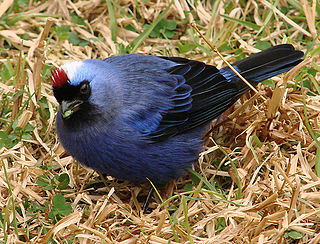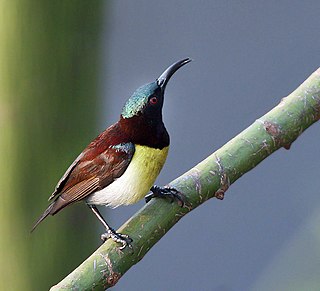
The whistling thrushes comprise a genus Myophonus of the Old World flycatcher family Muscicapidae.

The forktails are small insectivorous birds in the genus Enicurus. They were formerly placed in the thrush family, Turdidae, but are now treated as part of the Old World flycatcher family, Muscicapidae. Their common name derives from their long forked tail.

Coenraad Jacob Temminck was a Dutch patrician, zoologist and museum director.

The besra, also called the besra sparrowhawk, is a bird of prey in the family Accipitridae. It was formerly placed in the genus Accipiter. The name "besra" is from the Hindi word for the species.

The stork-billed kingfisher, is a tree kingfisher which is widely but sparsely distributed in the tropical Indian subcontinent and Southeast Asia, from India to Indonesia. This kingfisher is resident throughout its range.

The crested goshawk is a bird of prey in the family Accipitridae that is widely distributed in tropical Asia. It was formerly placed in the genus Accipiter.

The black-headed bulbul is a member of the bulbul family, Pycnonotidae. It is found in forests in south-eastern Asia.

The souimanga sunbird is a small passerine bird of the sunbird family, Nectariniidae. It is native to the islands of the western Indian Ocean where it occurs on Madagascar, the Aldabra Group and the Glorioso Islands.

The diademed tanager is a species of Neotropical bird in the tanager family Thraupidae. It is the only member of the genus Stephanophorus. It is purple-blue with a white crown characterised by a small red patch, and it is found mostly in open areas in southern Brazil, northeast Argentina, and Uruguay.

The scissor-tailed kite, also known commonly as the African swallow-tailed kite and the fork-tailed kite, is a bird of prey in the family Accipitridae. It is the only species placed in the genus Chelictinia. It is widespread in the northern tropics of Africa.

The western bearded greenbul is a species of songbird in the bulbul family, Pycnonotidae. It is found in West Africa. Its natural habitats are subtropical or tropical dry forests and subtropical or tropical moist lowland forests.

The ruby-cheeked sunbird is a species of sunbird in the family Nectariniidae.

The black-masked finch is a species of South American bird in the tanager family Thraupidae. It is the only member of the genus Coryphaspiza. It is found in Argentina, Bolivia, Brazil, Paraguay, and Peru. Its natural habitats are subtropical or tropical moist shrubland, subtropical or tropical dry lowland grassland, and subtropical or tropical seasonally wet or flooded lowland grassland. It is threatened by habitat loss.

The Javan flowerpecker, formerly named the blood-breasted flowerpecker, is a species of passerine bird in the flowerpecker family Dicaeidae. It is found on the Indonesian islands of Java and Bali in the Lesser Sunda Islands. Its natural habitats are subtropical or tropical moist lowland forest and subtropical or tropical moist montane forest. It was formerly considered to be conspecific with the Flores, Sumba, and Timor flowerpeckers.

The Sunda forktail is a species of bird in the family Muscicapidae. It is endemic to Indonesia, where it is restricted to the islands of Java and Sumatra. Its natural habitat is boulder strewn streams in tropical moist montane forest from 600–2000 m. More rarely the species occurs closer to sea level. The species is common in Sumatra, but is rarer in Java, where the white-crowned forktail is more common.

The purple-throated sunbird, is a species of bird in the family Nectariniidae. Its natural habitats are lowland tropical forests and tropical mangrove forests of Maratua and the Philippines.

The orange-backed woodpecker is a bird in the woodpecker family Picidae, found in southern Thailand, Malaya, Sarawak and Sabah in Malaysia, Brunei, Sumatra, and Java. It is monotypic in the genus Reinwardtipicus. It is a forest specialist that is found primarily in the canopy.

Leptocoma is a genus of sunbirds found from tropical South Asia to Papua New Guinea. Its members are sometimes included in Nectarinia.

This article provides a summary of significant events in 1820 in birding and ornithology. Notable occurrences in 1820 include the first description of the yellow-legged tinamou, and the commencement of ornithologist William John Swainson's Zoological Illustrations, a work including illustrations of many birds.

The ornate sunbird is a species of bird in the sunbird family Nectariniidae that is endemic to Mainland Southeast Asia, Sumatra, Java, Borneo and the Lesser Sunda Islands. It was formerly considered to be a subspecies of the olive-backed sunbird, now renamed the garden sunbird.




















